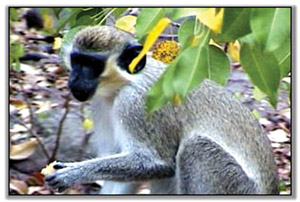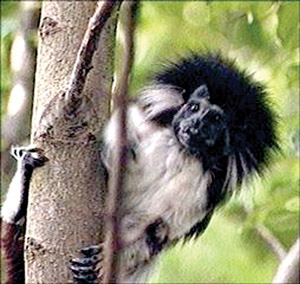Animal herbalists
 You
must be aware that we humans often turn to Mother Nature for plants of
medicinal value and other therapeutic substances, to heal many an
ailment. But, are you aware that a number of animals too actively use
them for a wide range of purposes? You
must be aware that we humans often turn to Mother Nature for plants of
medicinal value and other therapeutic substances, to heal many an
ailment. But, are you aware that a number of animals too actively use
them for a wide range of purposes?
Even though you may find it hard to believe, there are many
'herbalists' in the animal kingdom.
Scientific research has proved that many mammals and birds make use
of the therapeutic qualities of the
|

Macaws eating clay
|
plants in much the same way as we humans do. Perhaps, the most
common example of an animal herbalist is the chimpanzee.
It is said that Tanzanians consider Aspilia leaves (a genus of the
bushy plant related to the sunflower) to be an effective and powerful
antibiotic, against harmful bacteria and fungi. Even though the taste is
far too unpleasant for chewing, the leaves, which are also capable of
ridding the intestinal tract of parasite nematodes are used by them.
It has been revealed that chimpanzees living in the Gombe National
Park of Tanzania have been seen pulling leaves off any of the three
species of Aspilia. However, instead of just chewing the leaves, the
apes are said to roll them around their mouths for a while, the same way
humans do with medicinal pills, before swallowing them whole.
As these chimps eat the leaves first thing in the morning, scientists
are of the view that they may be acting as a stimulant too, just like
the cup of tea or coffee humans drink, shortly after waking up in the
morning.
|

Vervet monkey
|
Tanzanian chimps are also known to turn to another herbal remedy
popularly used by native tribes to counter parasites and stomach pains.
It is the bitter-tasting pith of the aptly named bitter leaf shrub. This
plant has helped the recovery of many a sick chimp in the park. Chimps
are also known to use the aloe plant which has a soothing gel for skin
irritation and injuries.
It is not only the chimps, certain African monkeys too are
accomplished herbalists. Would you believe that baboons eat the leaves
from the Sodom Apple to stop severe bouts of diarrhoea? They also eat
the fruits of the Balanites tree to cure parasitic infections. Female
baboons are said to eat the leaves of the candelabra tree for relief
from menstrual stomach cramps.
Other animals that are known to use various substances as medicine
are vervet or green monkeys, Zanzibar red colobuses and various
Madagascar lemurs. For example, the Zanzibar red colobus is said to eat
charcoal (which it steals from humans) to counter the toxic effects of
the protein-rich leaves of the mango and almond it feeds on.
Otherwise, the toxins would have a harmful effect on the functioning
of the monkey's digestive system.
Scientists also believe that certain apes and monkeys deliberately
eat some herbs to control reproduction and also the gender of their
offspring. Researchers also claim that even elephants may be eating the
bark of the red seringa tree to induce labour.
There are many in the avian world too who are experienced
'herbalists'. Some birds use even soil to neutralise
|

Zanzibar red colobus
|
toxic effects. For example, the green winged macaws and scarlet
macaws of South America are known to eat the riverbank soil or clay for
the kaolin it contains. They generally do so before they start hunting
for their food that usually contains toxins. Even the local Indians eat
kaolin to avoid severe gastric problems that could be caused by the
consumption of wild potatoes.
Birds not only eat leaves of medicinal value, they also use them in
their nests. For instance, eagles and various other birds of prey keep
parasitic insects out of their nests by using aromatic leaves. Such
leaves act as effective insecticides. Starlings too line their nests
with herbs that ward off or kill nest parasites.
The leaves of the paradise flower tree are rich in the anti-malarial
drug, quinine. It is recorded that scientists in Calcutta had discovered
that house sparrows line their nests and even chew on these leaves
during an outbreak of malaria. Usually the sparrows use the leaves from
the neem tree to line their nests. These leaves contain high
concentrations of insect repellent compounds.
So, don't you think it's fascinating that animals in the wilds also
have their own ways of healing and protecting themselves and their young
from various ailments? We often see our domestic pets, especially cats
and dogs eating special kinds of plants and grass for various reasons,
haven't we? It's the same with our friends in the
|

Madagascar lemur
|
jungles too. Read more about these animal herbalists whenever you
can.
****
Fact file
* North American brown bears and kodiak bears are known to dig out
the root of a medicinal plant called Ligusticum, chew it and then rub
the juices on their fur and faces.
The plant is noted to be effective in the treatment of stomachaches
and bacterial infections.
According to legend and folklore of the Navajos of southwest United
States, the bear is held in high esteem. It is said that the highly
revered bear spirit gave them this plant to use as medicine.
* Long before we humans discovered the medicinal value of plants and
other substances found in the natural environment, the animals in the
wild were aware of it.
In fact, we don't have to go to the jungles today to notice how
animals use such plants to cure certain ailments.
Our domesticated cats and dogs are ample evidence. It is said that
even the ancient Greek god named Asclepius respected the dogs very
highly for their ability to seek out medicinal herbs in the wild.
* Researchers are of the view that female chimpanzees may be eating
the leaves of certain Ziziphus (jujub) and Combretum species to reduce
the number of the local chimp population if it has become too large.
* The mantled howler monkey may be using plants to influence the
gender of its offspring.
* Female spider monkeys have been observed to eat more of a
particular legume nicknamed monkey ear which is supposed to be producing
a steroid that enhances fertility. Researchers are yet to determine
whether these monkeys do it deliberately or not. |
